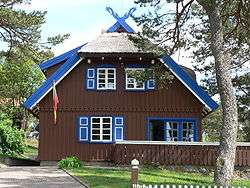Ašvieniai
Ašvieniai are divine twins in the Lithuanian mythology, identical to Latvian Dieva dēli and the Baltic counterparts of Vedic Ashvins.[1] Both names derive from the same Proto-Indo-European root for the horse – *ek'w-: Old Lithuanian ašva and Sanskrit ashva mean "horse".[2] Like the Greek Dioscuri Castor and Pollux, they are reflexes of a common Indo-European mytheme, the Divine Twins.[3]

Ašvieniai are represented as pulling a carriage of Saulė (the Sun) through the sky.[1] Ašvieniai, depicted as žirgeliai or little horses, are common motifs on Lithuanian rooftops,[1] placed for protection of the house.[4] Similar motifs can also be found on beehives, harnesses, bed frames, and other household objects.[5] Ašvieniai are related to Lithuanian Ūsinis and Latvian Ūsiņš (cf. Vedic Ushas), gods of horses.[6] Usins, one of the Ašvieniai, is described as driving a solar chariot pulled across the sky by a pair of white horses.[1]
References
- Hamacher, Duane W. "The Sumerians and Gemini: Sumerian Astronomical Interpretations as Origins of the Divine Horse Twins and Solar Chariots in Indo-European Mythology (Unpublished manuscript)" (PDF). p. 7. Archived from the original (PDF) on 2010-10-31.
- Indo-European etymology
- Parpola, Asko (2015). The Roots of Hinduism: The Early Aryans and the Indus Civilization. Oxford University Press. p. 109. ISBN 9780190226923.
- Dundulienė, Pranė (1991). Lietuvių etnologija (in Lithuanian). Mokslas. p. 50. ISBN 5-420-00713-4.
- Musteikis, Egidijus (2003-06-09). "Arklys tradicijose" (in Lithuanian). Horse Museum – Branch of A. Baranauskas and A. Vienuolis-Žukauskas Memorial Museum. Archived from the original on 2010-10-31. Retrieved 2010-01-07.
- Leeming, David Adams (2003). From Olympus to Camelot: The World of European Mythology. Oxford University Press. pp. 125–126. ISBN 0-19-514361-2.